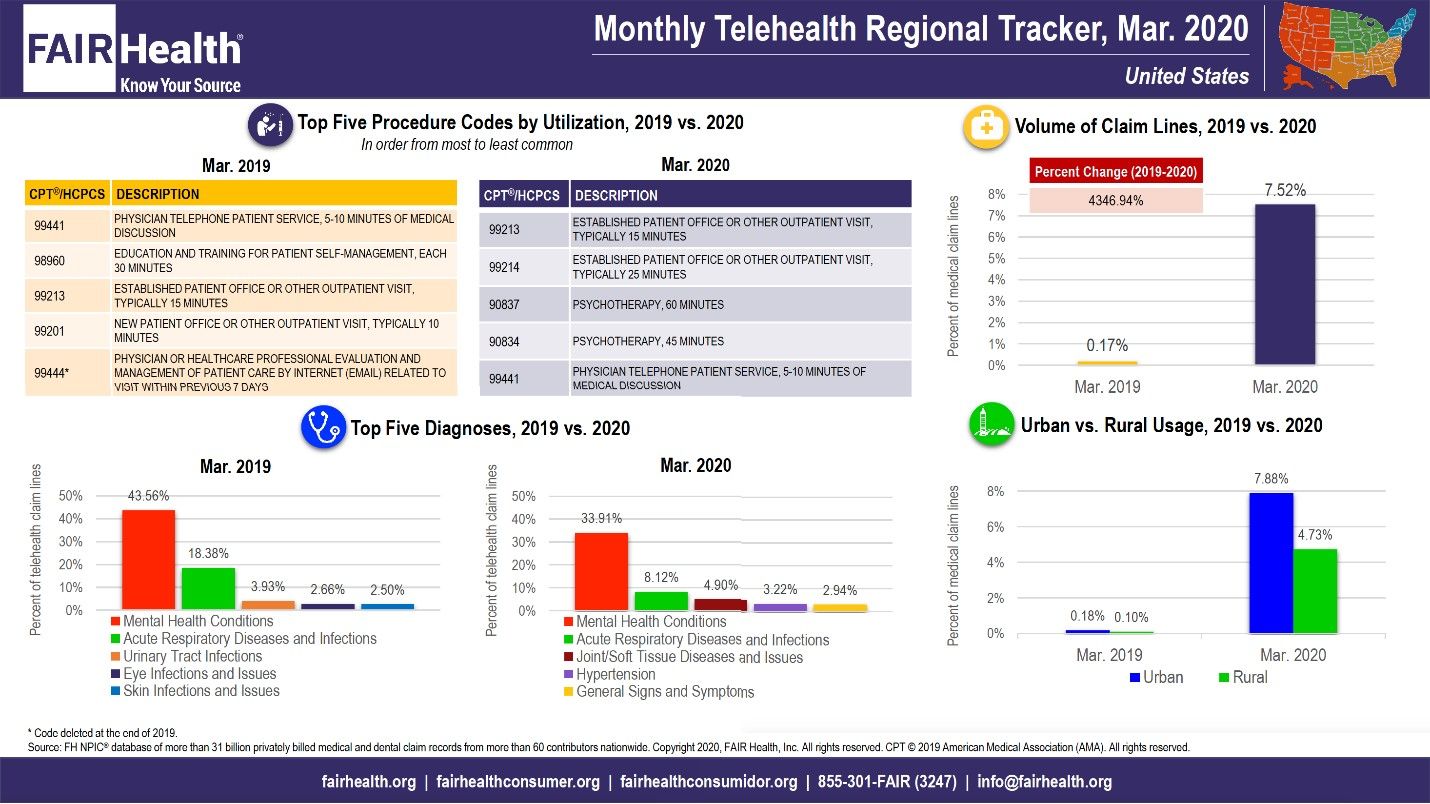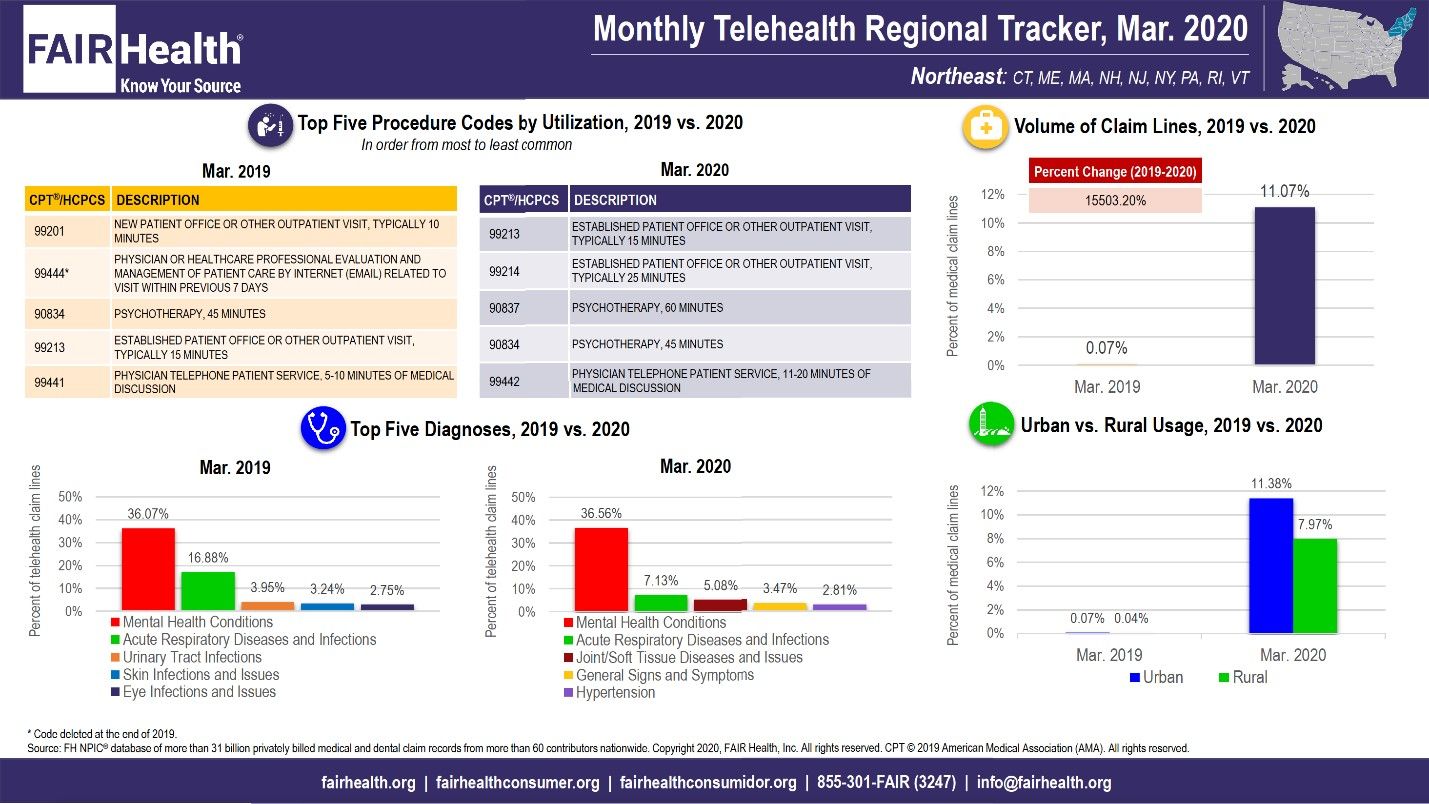- Center on Health Equity & Access
- Clinical
- Health Care Cost
- Health Care Delivery
- Insurance
- Policy
- Technology
- Value-Based Care
FAIR Health's Monthly Telehealth Regional Tracker Suggests Impact of COVID-19: Telehealth Claim Lines Increase 4347% Nationwide in a Year
Telehealth claim lines increased 4347% nationally from 0.17% of medical claim lines in March 2019 to 7.52% in March 2020, according to new data from FAIR Health’s Monthly Telehealth Regional Tracker (Figure 1). The data represent the privately insured population, excluding Medicare and Medicaid. In an indication that the growth was related to the COVID-19 pandemic, the increase was even greater in the Northeast, where the pandemic hit hardest in March. Telehealth claim lines grew 15,503% in the Northeast, from 0.07% of medical claim lines in March 2019 to 11.07% in March 2020 (Figure 2).
Figure 1. Monthly Telehealth Regional Tracker, March 2020, United States

Source: FAIR Health
Figure 2. Monthly Telehealth Regional Tracker, March 2020, Northeast

Source: FAIR Health
Telehealth had already been growing in recent years, but even faster growth has been predicted as a result of COVID-19. Telehealth permits healthcare services to be delivered without in-person contact, reducing the risk of disease transmission, and frees up in-person healthcare resources for COVID-19 patients. In addition, with fewer elective procedures occurring around the country due to widespread restrictions, the telehealth share of total medical claim lines was expected to increase.
Telehealth growth from February 2019 to February 2020, before the rapid escalation of the pandemic in the United States, was substantially lower. Nationwide, the increase as a percentage of medical claim lines in that period was 121%; in the Northeast, it was 174%.
Telehealth grew markedly from March 2019 to March 2020 in other US census regions, but not as much as in the Northeast. In the West, the increase as a percentage of medical claim lines was 1,986 percent; in the Midwest, 2842%; and in the South, 3427%.
Other notable findings of the Monthly Telehealth Regional Tracker concern diagnoses. From March 2019 to March 2020, acute respiratory diseases and infections decreased as a percentage of telehealth claim lines nationally and in all regions except the West. In March, there is typically a drop from February in acute respiratory diagnoses as a result of the seasonality of influenza, but this drop from March to March may indicate that many people with acute respiratory symptoms, fearing they had COVID-19, preferred this year to see a physician in person.
Nationwide, hypertension was one of the top 5 telehealth diagnoses in March 2020 whereas it was not in March 2019 or in February 2020. Increased issues with blood pressure for people with hypertension may be related to increased stress during the pandemic. Another factor may be increased telemonitoring of patients with hypertension so they do not need to go into the physician’s office to be monitored.
Launched in May as a free service, the Monthly Telehealth Regional Tracker uses FAIR Health data to track how telehealth is evolving on a monthly basis. An interactive map of the 4 US census regions allows the user to view an infographic on telehealth in a specific month in each region, or in the nation as a whole. In addition to data on the volume of claim lines and the top 5 diagnoses, each infographic includes findings on urban vs. rural usage and the top 5 procedure codes.
In this period of change, FAIR Health’s Monthly Telehealth Regional Tracker opens a timely window on how telehealth is being transformed. It is one of several ways we are seeking to make our data useful to healthcare stakeholders as the COVID-19 crisis continues.
For the Monthly Telehealth Regional Tracker, click here.
Author Information
Robin Gelburd, JD, is the President of FAIR Health, a national, independent nonprofit organization with the mission of bringing transparency to healthcare costs and health insurance information. FAIR Health possesses the nation’s largest collection of private healthcare claims data, which includes over 31 billion claim records contributed by payors and administrators who insure or process claims for private insurance plans covering more than 150 million individuals. Certified by the Centers for Medicare & Medicaid Services (CMS) as a national Qualified Entity, FAIR Health also receives data representing the experience of all individuals enrolled in traditional Medicare Parts A, B and D; FAIR Health houses data on Medicare Advantage enrollees in its private claims data repository. Ms. Gelburd is a nationally recognized expert on healthcare policy, data and transparency.
Preventing Respiratory Illness and Death Through Tighter Air Quality Standards
June 1st 2021On this episode of Managed Care Cast, a research scholar at the Marron Institute of Urban Management at New York University discusses the latest findings in the Health of the Air report, which was presented at the recent American Thoracic Society 2021 International Conference.
Listen
Health Care Utilization and Cost of Diagnostic Testing for Respiratory Infections
September 17th 2025Syndromic reverse transcriptase–polymerase chain reaction tests for respiratory infections were associated with lower health care resource utilization and costs, implicating potential for improved value in patient care.
Read More
